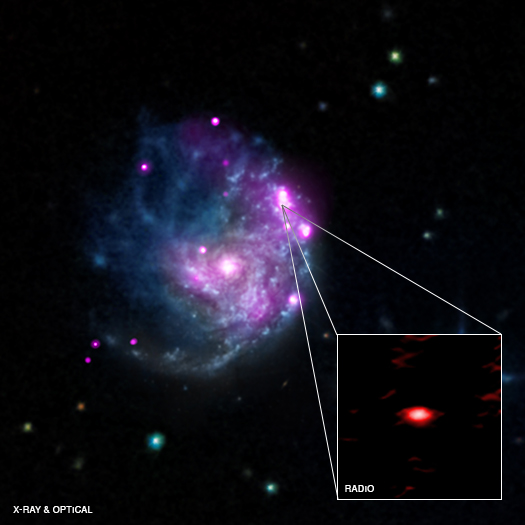Growing Black Holes: Hunting for the First Seeds

Mar Mezcua
We are pleased to welcome Mar Mezcua as a guest blogger today. She led the study that is the subject of our latest press release, about an intermediate mass black hole. Mar is from Balaguer (Lleida, Spain) and studied Physics in the University Autonomous of Barcelona and in the University of La Laguna, where she also specialized in Astrophysics. She completed her PhD at the Max-Planck-Institut fuer Radioastronomie (Bonn, Germany) in 2011 and then moved to the Instituto de Astrofisica de Canarias (Canary Islands, Spain) as a postdoctoral researcher. She is currently a postdoctoral researcher at the Harvard-Smithsonian Center for Astrophysics.
I found my calling when I was 13 years old and serendipitously watched a documentary on TV about galaxies and supermassive black holes. I wanted to become an astrophysicist and study these exciting objects!
Supermassive black holes reside at the center of galaxies and are more than a million times more massive than the Sun. As their name implies, they are black and thus cannot be observed directly. Hence, to detect black holes we have to observe the matter that surrounds and feeds them, this is, the material that the black hole “accretes.” In supermassive black holes, this accreting material heats up high enough to emit X-rays so that we can detect it with X-ray satellites like NASA’s Chandra X-ray Observatory. Some supermassive black holes also eject outflows of plasma or jets, which emit mainly at radio wavelengths.
During my PhD, I studied these radio jets using a technique that provides the highest angular resolution achievable in astronomy: very long baseline interferometry (VLBI). This technique takes the signal from multiple telescopes in different locations and synthesizes the data to get a much more detailed look at objects in space.
I used the European VLBI Network (EVN), an array of antennas spread throughout the world and that allows us to achieve the same resolution as a single antenna with a diameter of thousands of kilometers. This allowed us to search for galaxies that had two supermassive black holes at their centers. The presence of two supermassive black holes is expected in a galaxy that has undergone a merger with another galaxy. If this secondary galaxy is not as massive or is smaller than the main one, the merger is classified as “minor.” In minor mergers, the gas and dust of the secondary galaxy is stripped off during the merger and its central black hole can wander around the main galaxy. Such wandering black holes could be observed as ultraluminous X-ray sources (ULXs), which are extremely bright objects detected with X-ray satellites.
Hundreds of ultraluminous X-ray sources have been detected in the last 30 years; however, the nature of these sources is still a matter of debate. Some of them have been found to be black holes a few times more massive than the Sun (stellar-mass black holes) and accreting at the maximum rate allowed by physics. Meanwhile, others appear to be very compact stars emitting regular pulses, and the most luminous ones are suggested to be intermediate-mass black holes (IMBH). Such IMBHs are thought to weigh a thousand times more than the Sun, but a thousand times less than supermassive black holes. Therefore, IMBHs constitute the missing link between stellar-mass black holes and supermassive black holes. Astronomers have been looking for IMBHs for a very long time, due to their role as the possible seeds from which supermassive black holes grow. Despite their importance, only a handful of IMBHs have been discovered so far.
Together with Prof. Tim Roberts and Dr. Andy Sutton, from Durham University and experts in the analysis of X-ray data, and Dr. Andrei Lobanov, an expert in radio jets and VLBI, we studied a very bright ULX located in the spiral arm of a galaxy that seemed to have undergone a minor merger. This ULX, called NGC2276-3c, was an excellent IMBH candidate, so we observed it nearly simultaneously in the X-ray and radio bands with Chandra and the EVN, respectively. We found that the X-ray data were consistent with NGC2276-3c being in an X-ray state in which a black hole is expected to emit a radio jet, and the EVN observations indeed revealed the presence of a powerful radio jet with a size 1,000 times smaller than typically observed in supermassive black holes. All the results seemed to indicate that NGC2276-3c was, in fact, an IMBH.
However, to confirm it as an IMBH, we needed to estimate its black hole mass. For this purpose, we used the “fundamental plane of accreting black holes,” which is a correlation between the X-ray luminosity, the radio luminosity, and the black hole mass that has proved to be a valid formula for estimating the masses of both stellar-mass black holes and supermassive black holes. Using this correlation we found that NGC2276-3c has a black hole mass 5,000 times that of the Sun. Eureka! We had discovered an IMBH in the arm of a spiral galaxy and with a radio jet as powerful as that of supermassive black holes!
According to simulations, the jets of supermassive black holes are able to clear out a gap in the host galaxy, shutting down the formation of stars and regulating the amount of material that is available for accretion on to the supermassive black hole. The finding that this could also be produced by the jet of an IMBH like NGC2276-3c located in the spiral arm of a galaxy has strong implications for studies of supermassive black hole and galaxy growth. We will therefore keep on hunting for more IMBHs in minor merging galaxies!
Category:
Subcategory:
- Log in to post comments

